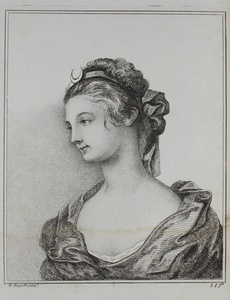| Method | Etching and stipple |
| Artist | Samuel Ireland after William Hogarth |
| Published | [c. 1794] |
| Dimensions | Image 174 x 140 mm, Plate 180 x 150 mm, Sheet 222 x 155 mm |
| Notes |
A portrait of the goddess Diana, after a painting by William Hogarth. From Samuel Ireland's 'Graphic Illustrations of Hogarth'. An earlier state of the plate, with a different inscription and without the artist's names below the image line, was separately published. Diana is portrayed at bust length, turned left, wearing a loose low cut dress and her hair tied us with a ribbon and band with a crescent moon. William Hogarth (1697 - 1764) was born in London, the son of an unsuccessful schoolmaster and writer from Westmoreland. After apprenticeship to a goldsmith, he began to produce his own engraved designs in about 1710. He later took up oil painting, starting with small portrait groups called conversation pieces. He went on to create a series of paintings satirising contemporary customs, but based on earlier Italian prints, of which the first was The Harlot's Progress (1731), and perhaps the most famous The Rake's Progress. His engravings were so plagiarised that he lobbied for the Copyright Act of 1735, commonly referred to as 'Hogarth's Act,' as a protection for writers and artists. During the 1730s Hogarth also developed into an original painter of life-sized portraits, and created the first of several history paintings in the grand manner. Samuel Ireland (1744 - 1800) was a British engraver, author, and collector of art and rare books, who specialised in series of 'Picturesque Views' with a particular focus on British rivers and waterways. In addition to his work as a topographical artist, he also etched a number of plates after Hogarth, Mortimer, and John Hamilton. His professional reputation was left in shambles following his unfortunate championing of a widely publicised hoax. A great admirer of Shakespeare, Ireland enthusiastically announced the discovery of a cache of Shakespeare manuscripts, which, after professional scrutiny, were proved to be forgeries created by his own son, William Ireland. Condition: Slight overall time toning. Water stain to lower end of image. |
| Framing | unmounted |
| Price | £75.00 |
| Stock ID | 46899 |

